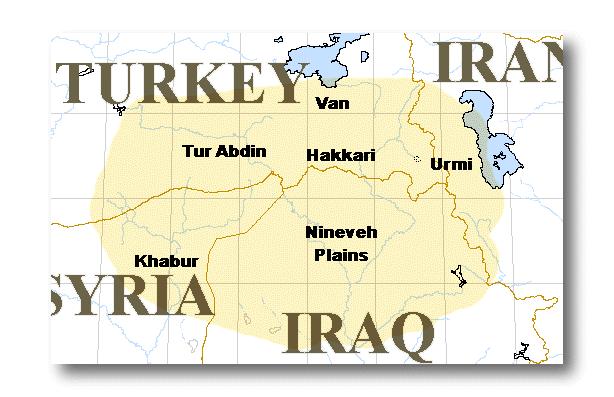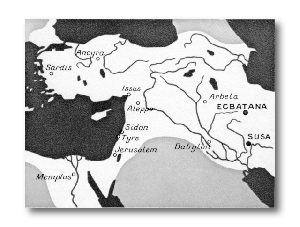Assyria is located in north Mesopotamia and spans four countries: In Syria it extends west to the Euphrates river; in Turkey it extends north to Harran, Edessa, Diyarbakir, and Lake Van; in Iran it extends east to Lake Urmi, and in Iraq it extends to about 100 miles south of Kirkuk. This is the Assyrian heartland, from which so much of the ancient Near East came to be controlled. Two great rivers run through Assyria, the Tigris and the Euhprates, and many lesser ones, the most important of which being the Upper Zab and Lower Zab, both tributaries to the Tigris. Strategically surrounding the Tigris and the two Zabs are the Assyrian cities of Nineveh, Ashur, Arbel, Nimrod and Arrapkha. To the north and east of Assyria lie the Taurus and Zagros mountains. To the west and south lies a great, low limestone plateau. At the southern end of Assyria the gravel plains give way to alluvium deposited by the Tigris, and farther south there is insufficient rainfall for agriculture without irrigation. These two features create a geogrpahical boundary between Assyria and the neighboring land to the south. To the south of Baghdad lies Babylon. There is a stark geographical distinction between Babylonia and Assyria. To quote Saggs, [[H. W. F. Saggs was one of the great British Orientalists who were, in a sense, the product of the Second World War]: A journey in spring from Baghdad, the capital of modern Iraq and within the Area of Ancient Babylonia, to Mosul [Nineveh], which is near several old Assyrian capitals, takes the traveller into what is manifestly a different country. In the region of Baghdad and southwards the predominant vegetation is palm trees. . .The terrain is flat to the horizon, and for most of the year its sun-parched earth is arid and dead wherever irrigation ditches do not reach. Approaching Mosul [Nineveh] the traveller finds a striking change. The flat terrrain gives way to undulating plains, in spring green with pasturage or cereal crop and gay and scented with flowers and clover. The rolling plains are cut with wadis, aflow after spring rains, with higher ranges of hills on the horizon. The traveller has reached Assyria.[Might that was Assyria, page 5] The Assyrian land is rich and fertile, with growing fields found in every region. Two large areas comprise the Assyrian breadbasket: the Arbel plain and the Nineveh plain. To this day these areas remain critical crop producers. This is from where Assyria derived her strength, as it could feed a large population of professionals and craftsman, which allowed it to expand and advance the art of civilization. Assyrians are a Semitic peoples indigenous to Mesopotamia. They are Mediterranean Caucasoids, and are ethnically distinct from Arabs and Jews. Assyrians have used two languages throughout their history: ancient Assyrian (Akkadian), and Modern Assyrian (neo-syriac). Akkadian was written with the cuneiform writing system, on clay tablets, and was in use from the beginning to about 750 B.C.. By 750 B.C., a new way of writing, on parchment, leather, or papyrus, was developed, and the people who brought this method of writing with them, the Arameans, would eventually see their language, Aramaic, supplant Ancient Assyrian because of the technological breakthrough in writing. Aramaic was made the second official language of the Assyrian empire in 752 B.C. Although Assyrians switched to Aramaic, it was not wholesale transplantation. The brand of Aramaic that Assyrians spoke was, and is, heavily infused with Akkadian words, so much so that scholars refer to it as Assyrian Aramaic. Assyrians have practiced two religions throughout their history: Ashurism and Christianity. Ashurism was, of course, the first religion of the Assyrians. The very word Assyrian, in its Latin form, derives from the name of Ashur, the Assyrian god. Assyrians continued to practice Ashurism until 256 A.D, although by that time, most Assyrians had accepted Christianity. Indeed, Assyrians were the first nation to accept Christianity, and the Assyrian Church was founded in 33 A.D. by Thomas, Bortholemew and Thaddeus. We come now to the beginning of greatest expansion of the Assyian empire with Tiglath-Pileser III (745-727); through a series of able kings, Sargon II, Sennacherib, Esarhaddon, Ashurbnaipal, Assyria would extend its rule over a vast area, from Egypt up to cyprus to the west, through Anatolia, to the Caspian in the east. The Assyrian empires, particularly the third one, had a profound and lasting impact on the Near East. Before Assyrian hegemony would come to an end, the Assyrians would bring the highest civilization to the then known world. From the Caspian to Cyprus, from Anatolia to Egypt, Assyrian imperial expansion would bring into the Assyrian sphere nomadic and barbaric communities, and would bestow the gift of civilization upon them. And though today we are far removed from that time, some of our most basic and fundamental devices of daily survival, to which we have become so accustomed that we cannot conceive of life without them, originated in Assyria. One cannot imagine leaving his home without locking the door; it is in Assyria where locks and keys were first used. One cannot survive in this world without knowing the time; it is in Assyria that the sexagesimal system of keeping time was developed. One cannot imagine driving without paved roads; it is in Assyria where paved roads were first used. And the list goes on, including the first postal system, the first use of iron, the first magnifying glasses, the first libraries, the first plumbing and flush toilets, the first electric batteries, the first guitars, the first aqueducts, the first arch, and on and on. But it is not only things that originated in Assyria, it is also ideas, ideas that would shape the world to come. It is the idea, for example, of imperial administration, of dividing the land into territories administered by local governors who report to the central authority, the King of Assyria. This fundamental model of administration has survived to this day, as can be seen in America's federal-state system. It is in Assyria where the mythological foundation of the old and new testament is found. It is here that the story of the flood originates, 2000 years before the old testament is written. It is here that the first epic is written, the Epic of Gilgamesh, with its universal and timeless theme of the struggle and purpose of humanity. It is here that civilization itself is developed and handed down to future generations. It is here where the first steps in the cultural unification of the Middle East are taken by bringing under Assyrian rule the diverse groups in the area, from Iran to Egypt, breaking down ethnic and national barriers and preparing the way for the cultural unification which facilitated the subsequent spread of Hellenism, Judaism, Christianity and Islam. Second Golden Age: 33 A.D. to 1300 A.D. Armed with the word of God, and after 600 years of dormancy, the Assyrians once again set out to build an empire, not a military empire, but a religious empire founded on divine revelation and Christian brotherhood. So successful was the Assyrian missionary enterprise, by the end of the twelfth century the Assyrian Church was larger than the Greek Orthodox and Roman Catholic churches combined, and it spanned the Asian continent, from Syria to Mongolia, Korea, China, Japan and the Philippines. When Marco Polo visited China in the thirteenth century, he was astonished to find Assyrian priests in the Chinese royal court, and tens of thousands of Chinese Christians. The Assyrian missionaries had reached China in the sixth century. With only the bible, a cross, and a loaf of bread in hand, these messengers had walked thousands of miles along the old silk road to deliver the word of God. So successful were the missionaries, when Genghis Khan swept through Asia, he brought with him an army over half of which belonged to the Assyrian Church of the East. So successful were the missionaries, the first Mongolian system of writing used the Assyrian alphabet. Armed with the word of God, Assyrians once again transformed the face of the Middle East. In the fourth, fifth, and sixth centuries they began a systematic translation of the Greek body of knowledge into Assyrian. At first they concentrated on the religious works but then quickly moved to science, philosophy and medicine. Socrates, Plato, Aristotle, Galen, and many others were translated into Assyrian, and from Assyrian into Arabic. It is these Arabic translations which the Moors brought with them into Spain, and which the Spaniards translated into Latin and spread throughout Europe, thus igniting the European renaissance. By the sixth century A.D., Assyrians had begun exporting back to Byzantia their own works on science, philosophy and medicine. In the field of medicine, the Bakhteesho Assyrian family produced nine generations of physicians, and founded the great medical school at Gundeshapur. Also in the area of medicine, Hunayn ibn-Ishaq*s textbook on ophthalmology, written in 950 A.D., remained the authoritative source on the subject until 1800 A.D. In the area of philosophy, the Assyrian philosopher Job of Edessa developed a physical theory of the universe, in the Assyrian language, that rivaled Aristotle*s theory, and that sought to replace matter with forces. One of the greatest Assyrian achievements of the fourth century was the founding of the first university in the world. The School of Nisibis had three departments: theology, philosophy and medicine, and became a magnet and center of intellectual development in the Middle East. The statutes of the School of Nisibis, which have been preserved, later became the model upon which the first Italian university was based. When Arabs and Islam swept through the Middle East in 630 A.D., they encountered 600 years of Assyrian Christian civilization, with a rich heritage, a highly developed culture, and advanced learning institutions. It is this civilization which became the foundation of the Arab civilization. But this great Assyrian Christian civilization would come to an end in 1300 A.D. The tax which the Arabs levied on Christians, simply for just being Christian, forced many Assyrians to convert to Islam to avoid the tax; this inexorably drained the community, so that by the time Timurlane the Mongol delivered the final blow in 1300 A.D., by violently destroying most cities in the Middle East, the Assyrian Christian community had dwindled to its core in Assyria, and henceforth the Assyrian Church of the East would not regain its former glory, and the Assyrian language, which had been the lingua franca of the Middle East until 900 A.D., was completely supplanted by Arabic (except amongst the Assyrians). This, from 1300 A.D. until World War One, became the second Assyrian dark age. Second Dark Age: 1300 A.D. to 1918 A.D. -------------------![]()
Peter BetBasoo
![]()
Language 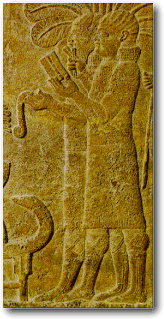
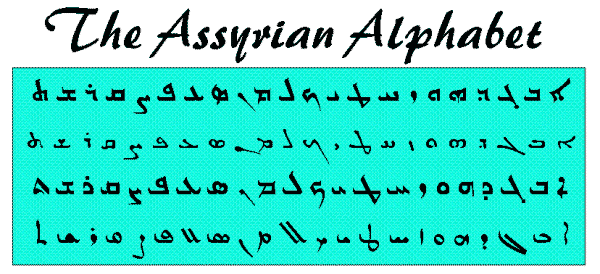
![]()
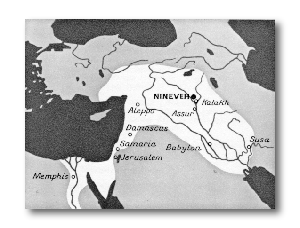
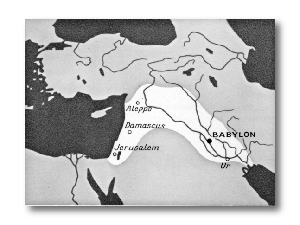
![]()
![]()
Assyrians continued living in their homeland throughout this dark age, until that momentous moment in human history, when the Lord Son of God gave himself for the salvation of mankind. Very soon after the crucifixion, the bulk of the Assyrian population converted to Christianity, although there remained to be Ashurites, until 256 A.D. It was the Apostle Thomas, with Thaddeus and Bartholomew who came to the Assyrian city of Edessa and founded the Assyrian Church of the East, the first and oldest church in the world. ![]()
The Assyrian missionary enterprise, which had been so successful throughout the Asian continent, came to an abrupt end with the coming of Timurlane the Mongol. The indiscriminate destruction leveled by Timurlane against the civilizations he encountered put to a permanent end the Assyrian missionary enterprise. A large segment of the Assyrian population escaped the ravages of Timurlane by fleeing into the Hakkary mountains (present day eastern Turkey); the remaining Assyrians continued to live in their homelands (presently North Iraq and Syria), and Urmi. The four Assyrian communities, over time, begin defining themselves in terms of their church affiliation. The western Assyrians, all of whom belonging to the Syrian Orthodox Church, began identifying themselves as "Jacobites". The remaining communities belonged to the Assyrian Church of the East. After the division of the Church of the East in 1550 A.D., the Chaldean Church of Babylon, a Roman Catholic Uniate, was created, and members of this church began to call themselves Chaldean. By the end of the nineteenth century, these three communities no longer saw themselves as one and the same.
__._,_.___
*****************************************
Sign the Petition : Release the Arrested University Teachers Immediately : An Appeal to the Caretaker Government of Bangladesh
http://www.mukto-mona.com/human_rights/university_teachers_arrest.htm
*****************************************
Daily Star publishes an interview with Mukto-Mona
http://www.mukto-mona.com/news/daily_star/daily_star_MM.pdf
*****************************************
MM site is blocked in Islamic countries such as UAE. Members of those theocratic states, kindly use any proxy (such as http://proxy.org/) to access mukto-mona.
*****************************************
Mukto-Mona Celebrates 5th Anniversary
http://www.mukto-mona.com/Special_Event_/5_yrs_anniv/index.htm
*****************************************
Mukto-Mona Celebrates Earth Day:
http://www.mukto-mona.com/Special_Event_/Earth_day2006/index.htm
*****************************************
Kansat Uprising : A Special Page from Mukto-Mona
http://www.mukto-mona.com/human_rights/kansat2006/members/
*****************************************
MM Project : Grand assembly of local freedom fighters at Raumari
http://www.mukto-mona.com/project/Roumari/freedom_fighters_union300306.htm
*****************************************
German Bangla Radio Interviews Mukto-Mona Members:
http://www.mukto-mona.com/Special_Event_/Darwin_day/german_radio/
Mukto-Mona Celebrates Darwin Day:
http://www.mukto-mona.com/Special_Event_/Darwin_day/index.htm
*****************************************
Some FAQ's about Mukto-Mona:
http://www.mukto-mona.com/new_site/mukto-mona/faq_mm.htm
****************************************************
VISIT MUKTO-MONA WEB-SITE : http://www.mukto-mona.com/
****************************************************
"I disapprove of what you say, but I will defend to the death your right to say it".
-Beatrice Hall [pseudonym: S.G. Tallentyre], 190
Change settings via the Web (Yahoo! ID required)
Change settings via email: Switch delivery to Daily Digest | Switch to Fully Featured
Visit Your Group | Yahoo! Groups Terms of Use | Unsubscribe
__,_._,___
